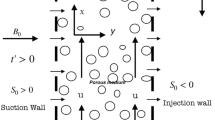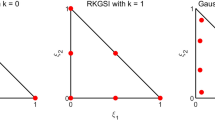Abstract
An input/output framework is used to analyze the sensitivity of two- and three-dimensional disturbances in a compressible boundary layer for changes in wall and momentum forcing. The sensitivity is defined as the gradient of the kinetic disturbance energy at a given downstream position with respect to the forcing. The gradients are derived using the parabolized stability equations (PSE) and their adjoint (APSE). The adjoint equations are derived in a consistent way for a quasi-two-dimensional compressible flow in an orthogonal curvilinear coordinate system. The input/output framework provides a basis for optimal control studies. Analysis of two-dimensional boundary layers for Mach numbers between 0 and 1.2 show that wall and momentum forcing close to branch I of the neutral stability curve give the maximum magnitude of the gradient. Forcing at the wall gives the largest magnitude using the wall normal velocity component. In case of incompressible flow, the two-dimensional disturbances are the most sensitive ones to wall inhomogeneity. For compressible flow, the three-dimensional disturbances are the most sensitive ones. Further, it is shown that momentum forcing is most effectively done in the vicinity of the critical layer.
Similar content being viewed by others
References
Airiau, C., Non-parallel acoustic receptivity of a Blasius boundary layer using an adjoint approach. Flow,Turbulence and Combustion 65 (2000)347–367.
Airiau, C., Walther, S. and Bottaro, A., Non-parallel receptivity and the adjoint PSE. In: Fasel, H. and Saric, W. (eds), IUTAM Symposium on Laminar-Turbulent Transition, Sedona, AZ, September 1999. Springer-Verlag, Berlin (2000).
Andersson, Berggren,M. and Henningson, D.S., <nt> </nt>Optimal disturbances and bypass transition in boundary layer. Phys. Fluids 11 (1999)134–150.
Andersson, P., Henningson, D.S. and Hanifi, A., On a stabilization procedure for the parabolic stability equations. J. Engrg. Math. 33 (1998)311–332.
Bewley, T.R., Temam, R. and Ziane, M., A general framework for robust control in fluid mechanics. Physica D 138 (2000)360–392.
Bertolotti, F.P., Herbert, Th. and Spalart, S.P., Linear and nonlinear stability of the Blasius boundary layer. J. Fluid Mech. 242 (1992)441–474.
Cathalifaud, P. and Luchini, P., Algebraic growth in a boundary layer: Optimal control by blowing and suction at the wall. Eur. J. Mech. B/Fluids 19(4) (2000)469–490
Choudhari, M. and Street, C.L., A finite Reynolds-number approach for the prediction of boundary-layer receptivity in localized regions. Phys. Fluids A 4 (1992)2495–2514.
Corke, T.C., Bar-Sever, A. and Morkovin, M.V., Experiments on transition enhancement by distributed roughness. Phys. Fluids. 29 (1986)3199–3213.
Crouch, J.D., Localized receptivity of boundary layers. Phys. Fluids A 4 (1992)1408–1414.
Crouch, J.D., Non-localized receptivity of boundary layers. J. FluidMech. 244 (1992)567–581.
Goldstein, M.E., The evolution of Tollmien-Schlichting waves near the leading edge. J. Fluid Mech. 127 (1983)59–81.
Goldstein, M.E. and Hultgren, L.S., Boundary-layer receptivity to long-wave free-stream disturbances. Ann. Rev. Fluid Mech. 21 (1989)137–166.
Gunzburger, M., Adjoint equation-based methods for control problems in incompressible, viscous flows. Flow, Turbulence and Combustion 65 (2000)249–272.
Hall, M.C.G., Application of adjoint sensitivity theory to an atmospheric general circulation model. J. Atmospheric Sci. 43 (1986)2644–2651.
Hanifi, A., Henningson, D.S., Hein, S., Bertolotti, F.P. and Simen, M., Linear non-local instability analysis-The linear NOLOT code. FFA TN 1994–54 (1994), see also Hein et al.
Hanifi, A. and Schmid, P.J. and Henningson, D.S., Transient growth in compressible boundary layer flow. Phys. Fluids 8(3) (1996)826–837.
Hein, S., Bertolotti, F.P., Simen, M., Hanifi, A. and Henningson, D.S., Th., Parabolized stability equations. AGARD Report No. 793 (1994)pp.4–1–4–34.
Hill, D.C., Adjoint systems and their role in the receptivity problem for boundary layers. J. Fluid Mech. 292 (1995)183–204.
Hill, D.C., Receptivity in non-parallel boundary layers. In: Proceedings of the 1997 Fluids Engineering Division Summer Meeting, FEDS97–3108, Vancouver, Canada, June 22–26. ASME, New York (1997).
Högberg, M. and Berggren, M., Numerical approaches to optimal control of a model equation for shear flow instabilities. Flow,Turbulence and Combustion (2000) submitted.
Li, F. and Malik, M.R., On the nature of PSE approximation. Theor. Comput. Fluid Dynam. 8 (1996)253–273.
Luchini, P. and Bottaro, A., Görtler vortices: A backward-in-time approach to the receptivity problem. J. Fluid Mech. 363 (1998)1–23.
Luchini, P., Reynolds-number-independent instability of the boundarylayer over a flat surface: Optimal perturbations. J. Fluid Mech. 404 (2000)289–309.
Mack, L.M., Boundary-layer stability theory. AGARD Report No. 709 (1986)pp.3–1–3–81.
Nishioka, M. and Morkovin, M.V., Boundary-layer receptivity to unsteady pressure gradients: experiments and overview. J. Fluid Mech. 171 (1986)219–261.
Pralits, J.O., Hanifi, A. and Henningson, D.S., Adjoint-based suction optimization for 3D boundary layer flows. FFA TN (2000)2000–58.
Saric, W.S., Physical description of boundary-layer transition: Experimental evidence. AGARD Report No. 793 (1993)pp.183–204.
Simen, M., Local and nonlocal stability theory of spatially varying flows. In: Hussaini, H.Y., Kumar, A. and Streett, C.L. (eds), Instability, Transition and Turbulence. Springer-Verlag, Berlin (1992)pp.181–201.
Thomas, A., The control of boundary-layer transition using a wave superposition principle. J. Fluid Mech. 137 (1983)233–250.
Tumin, A., Receptivity of pipe Poiseuille flow. J. Fluid Mech. 315 (1996)119–137.
Author information
Authors and Affiliations
Rights and permissions
About this article
Cite this article
Pralits, J., Airiau, C., Hanifi, A. et al. Sensitivity Analysis Using Adjoint Parabolized Stability Equations for Compressible Flows. Flow, Turbulence and Combustion 65, 321–346 (2000). https://doi.org/10.1023/A:1011434805046
Issue Date:
DOI: https://doi.org/10.1023/A:1011434805046




